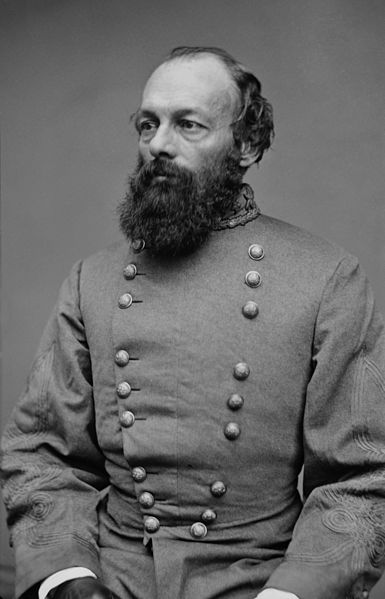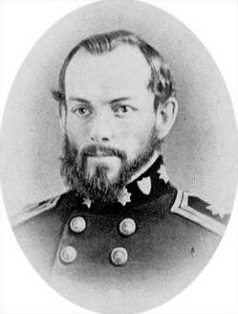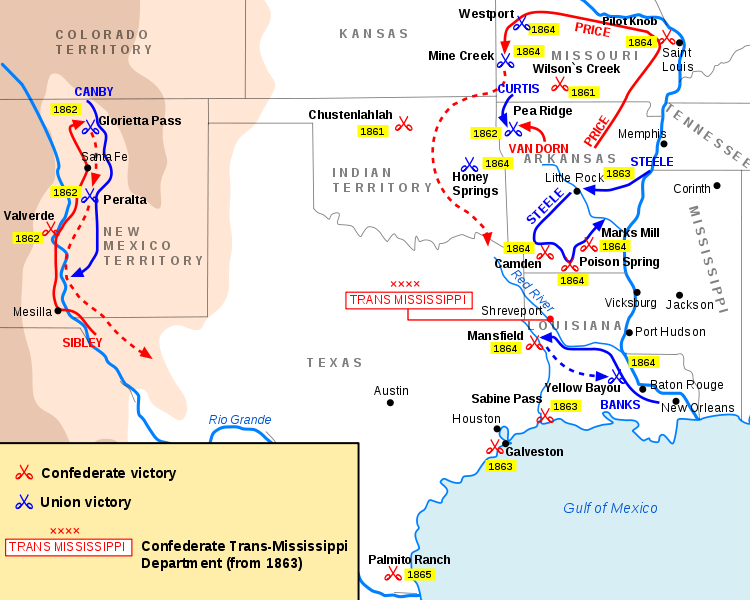<Back to Index>
- Inventor David Edward Hughes, 1831
- Composer Juan Morel Campos, 1857
- General of the Confederate States Army Edmund Kirby Smith, 1824
PAGE SPONSOR


Edmund Kirby Smith (May 16, 1824 – March 28, 1893) was a career United States Army officer and educator. He served as a general in the Confederate States Army during the American Civil War, notable for his command of the Trans - Mississippi Department of the Confederacy after the fall of Vicksburg. After the conflict ended Smith worked in both the telegraph and railway business, and also served as a college professor until his death.
Smith was born in St. Augustine, Florida, to Joseph Lee Smith and Frances Kirby Smith. Both his parents were natives of Connecticut, and moved to Florida in 1821 shortly before the elder Smith was named a U.S. District Judge there. In 1836, his parents sent him to a military boarding school in Virginia, which he attended until his enrollment in the United States Military Academy at West Point, New York.
On July 1, 1841, Smith entered West Point and graduated four years later, standing 25th out of 41 cadets. While there he was nicknamed "Seminole" after his native state, and brevetted a second lieutenant in the 5th U.S. Infantry on July 1, 1845. He was promoted to second lieutenant on August 22, 1846, now serving in the 7th U.S. Infantry.
In the Mexican - American War he served under General Zachary Taylor at the Battle of Palo Alto and the Battle of Resaca de la Palma. He served under General Winfield Scott later, and received brevet promotions to first lieutenant for Cerro Gordo and to captain for Contreras and Churubusco. His older brother, Ephraim Kirby Smith, a captain in the regular army, served with him in the 5th U.S. Infantry in both the campaign with Taylor and Scott, until he died from wounds suffered at the Battle of Molino del Rey in 1847.
After that war, he served as a captain in the 2nd U.S. Cavalry, primarily in Texas, but he also taught mathematics at West Point and was wounded in his thigh on May 13, 1859, fighting Indians in the Nescutunga Valley of Texas. When Texas seceded, Smith, now a major, refused to surrender his command at Camp Colorado in what is now Coleman, Texas, to the Texas State forces under Col. Benjamin McCulloch and expressed his willingness to fight to hold it. On January 31, 1861, Smith was promoted to major, but resigned his commission in the U.S. Army on April 6 to join the Confederacy.
On March 16, 1861, Smith entered the Confederate forces as a major in the regular artillery, and was transferred to the regular cavalry that same day with the rank of lieutenant colonel. After serving briefly as Brig. Gen. Joseph E. Johnston's assistant adjutant general in the Shenandoah Valley, Smith was promoted to brigadier general on June 17, 1861, and given command of a brigade in the Army of the Shenandoah, which he led at the First Battle of Bull Run on July 21. Wounded severely in the neck and shoulder, he recuperated while commanding the Department of Middle and East Florida. He returned to duty on October 11 as a major general and division commander in the Confederate Army of Northern Virginia, operating in northern Virginia.
In February 1862, Smith was sent west to command the Army of East Tennessee. Cooperating with Gen. Braxton Bragg in the invasion of Kentucky, he scored a victory at the Battle of Richmond on August 30, 1862, and was named on October 9 to the newly created grade of lieutenant general, becoming a corps commander in the Army of Tennessee. Smith would also receive the "Thanks of Congress" on February 17, 1864, for his actions at Richmond.
On
January 14, 1863, Smith was transferred to command the
Trans - Mississippi Department (primarily Arkansas, Western Louisiana, and Texas) and he remained west of the
Mississippi River for the balance of the war, based part of this time in Shreveport, Louisiana. As forces under Union Maj. Gen. Ulysses S. Grant tightened
their grip on the river, Smith attempted to intervene. However, his
department never had more than 30,000 men stationed over an immense
area and he was not able to concentrate forces adequately to challenge
Grant nor the Union Navy on the river.
In the spring of 1864, Lt. Gen. Richard Taylor, directly under Smith's command, soundly defeated Maj. Gen.Nathaniel P. Banks at the Battle of Mansfield in the Red River Campaign on April 8, 1864. After the Battle of Pleasant Hill on April 9, Smith joined Taylor and dispatched half of Taylor's Army, Walker's Greyhounds, under the command of Maj. Gen. John George Walker northward to defeat Union Maj. Gen. Frederick Steele's incursion into Arkansas. This decision, strongly opposed by Taylor, caused great enmity between the two men.
With the pressure relieved, Smith attempted to send reinforcements east of the Mississippi but, as in the case of his earlier attempts to relieve Vicksburg, it proved impracticable because of Union naval control of the river. Instead he dispatched Maj. Gen. Sterling Price, with all available cavalry, on an unsuccessful invasion of Missouri. Thereafter the war west of the river was principally one of small raids and guerrilla activity. By now a full general (as of February 19, 1864, one of only seven such men in the Confederacy), he negotiated the surrender his department — the only significant Confederate field army left — on May 26, 1865, and signed the terms of surrender in Galveston, Texas, on June 2, whence he fled to Mexico and then to Cuba to escape potential prosecution for treason. He returned to take an oath of amnesty at Lynchburg, Virginia, on November 14, 1865.
After the war, Smith was active in the telegraph business and education. From 1866 to 1868, he was president of the Atlantic and Pacific Telegraph Company. When that effort ended in failure, he started a preparatory school in New Castle, Kentucky. In 1870, he combined efforts with former Confederate general officer Bushrod Johnson and became president of the University of Nashville. In 1875, he left that post to become professor of mathematics at the University of the South at Sewanee from 1875 to 1893. At the time of his death in Sewanee, he was the last surviving man who had been a full general in the war. He is buried in the University Cemetery at Sewanee.
A men's dormitory building on the campus of LSU in Baton Rouge is named Kirby - Smith Hall. The state of Florida erected a statue honoring General Smith in the National Statuary Hall Collection of the United States Capitol in Washington, D.C. He is memorialized (as Edmund Kirby - Smith) at Sewanee by the Kirby - Smith Memorial on University Avenue, by Kirby - Smith Point on the edge of the South Cumberland Mountains on the University Domain, and in the naming of the Kirby - Smith Chapter of the United Daughters of the Confederacy at Sewanee, and in the naming of the Kirby - Smith Camp 1209, Sons of Confederate Veterans, Jacksonville, Florida. The Alachua County Public Schools administrative building, which was built in 1903, is named for Kirby - Smith.
He is memorialized with a tablet and in a stained glass window at the university's All Saints Chapel, and in a painting in the university's Jessie Ball du Pont Library and in a painting in the Chapter Room of the Tennessee Omega Chapter of the Sigma Alpha Epsilon Fraternity House. During World War II the 422 foot (129 m) Liberty Ship SS E. Kirby Smith was built in Panama City, Florida, in 1943, named in his honor.
Alexander H. Darnes (1840 - February 11, 1894) was an African American born
into slavery in the same home as Smith in St. Augustine, Florida.
Darnes was the son of Violent Pinkney, a black slave owned by Smith's
parents. He served as Smith's personal valet starting from 1855 and
continuing throughout the Civil War after which he would go on to
medical school and became one of the first black physicians in the
state of Florida.
